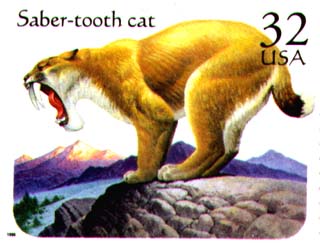Anth 3511 Professor Gibbon
Early Hunter-Gatherers on the West Coast
1. Introduction.
A. Far West prehistory can be divided into four general periods: (1) Prior to 8000 BC. Glaciers existed in the mountains and large lakes frlled the valleys of the Great Basin and southern California deserts. Mammoth and other Ice Age animals roamed a cooler, more lush, and greener landscape than now exists. People mainly hunters.
(2) Transition period 8000-5000 BC. Post-glacial warming and drying were eliminating glaciers and pluvial lakes. Arid and semi arid desert vegetation beginning to dominate. A period of rapid and extensive environmental change. Increasing trend toward broad spectrum hunting and gathering. (3) 5000 BC-1000BC/AD500. Glaciers, pluvial lakes, and Ice Age animals are gone. A-id and semiarid vegetation dominate most of California, the Great Basin, and the Plateau; the Northwest coast and the higher areas of California were covered with forests. Broad spectrum hunter-gatherers, with ocean fishing and sea mammal hunting now important. (4) C. 1000 BC in California, 500 BC in the Plateau and western Great Basin, and AD 500 in eastern Great Basin trends developed toward increasing populations, intensified subsistence activity, and growing societal complexity and interaction.
B. Look today and next time at California and the Northwest Coast.
2. The Natural Environment:
A. The West Coast one of richest marine environments on earth. B. Northwest Coast a damp, lush forest belt bordered by coastal mountains. C. California very diverse, with desert in the south and east, seacoast on the west, a great central valley with summer-dry grassland, and heavily wooded mountain ranges (Coastal Range, Sierra Nevada). A patchwork of environments.
D. These patterns of resource availability strongly influenced population density, settlement size, food-getting strategies, and group interaction. (1) At contact, a great diversity of societies, from highly mobile bands to chiefdoms with large, permanent communities.
(2) Sea mammal hunting and ocean fishing especially important along the Northwest Coast and in central and southern California, where some of most complex hunter-gatherer societies in the world developed. (3) In Northwest Coast, most settlement on river banks and on islands and shores of the coast, especially north of the mouth of the Columbia River. (4) High population densities in California in the Lower Sacramento and San Joaquin valleys, San Francisco Bay and Santa Barbara Channel areas; easy access to sea or protected by islands from surf.
1. First Settlement of the West Coast (c.9000-5000 BC).
A. Poorly understood; many sites under water and material culture perishable. But clear trend toward intensive foraging and coastal fishing and sea mammal hunting. A rapidly changing environment.
B. Northwest Coast. Paleomarine period (e.g., Ground Hog and Namu sites). Fishing economies (salmon, herring fisheries) at least by 5000 BC; semisedentary winter settlements; result of environmental changes (warmer water)
C. California. Basic coastal adaptation of shellfish collecting, fishing, sea mammal hunting flourishing by at least 8500 BC. @aisy Cave). After c. 6000 BC seed and nut harvesting back from coast (baskets, skin bags, digging sticks, manes and metates for milling). Large shell middens and bigger sites
4. Northwest Coast Middle Period (3500 BC-AD 500).
A. Clear emergence of Northwest Coast cultural tradition. Tempo of change increases significantly after 3000 BC. Traits and trends include: (1) rapid intensification of shellfish collection with increase in midden size (2) large-scale fishing appears with specialized technology (e.g., fish weirs) (3) much larger populations reflected in increasing food production in general (4) improving storage technology (5) more specialized woodworking tools (finely made polished chisels and adze blades after AD 450); large plank houses and fine woodworking (6) highly sophisticated baskets (7) greater cultural homogeneity throughout the Northwest Coast (8) widespread trade (e.g., obsidian) (9) signs of social ranking and societal complexity by 1000 BC (e.g., stone labrets, cranial deformation; costly and exotic grave goods after 500 BC); slavery; increased conflict with neighboring groups; large surpluses accumulated and redistributed by chiefs; beginnings of potlatches.
5. Northern California Early Archaic (6000-1500 BC).
Fairly isolated, mobile Archaic gatherers of wild vegetable foods in the rocky, mountainous area of northern California, both on coast and inland. Small populations with little of the later cultural elaboration that appears in the area.
6. Southern California Early Period (60000-1000 BC).
A. Sea level rose 50 feet by 4000 BC so many early sites beneath sea; but don't see rapid population rise until c. 3500 BC. A period of complex environmental changes (rising sea levels, kelp bed fluctuations, Altithermal)
B. An Archaic life-way that grew out of earlier Paleoindian with addition of seed processing equipment (manes and metates, mortars and pestles). Traits are:
(1) An Early Holocene maritime adaptation along coast and on offshore islands that is one of the oldest maritime traditions in the Americas (8500looo BC)
(2) A seasonal cycle develops by 3500 BC in which fall nut and seed harvests alternate with shellfishing, sea mammal hunting, and fishing at other periods; population size increases; mortars and pestles (greater acorn exploitation), and greater emphasis on fishing and sea mammal hunting, after 3500 BC.
(3) An increasing investment in acorn processing through time; acorns can be easily stored. Perhaps related to disappearance of coastal sea-bearing grasslands by 3500 BC.
(4) Semi-subterranean pithouses with numerous manes and metates at larger seasonal basecamps. Some dead buried in red-ocher sprinkled graves. (5) Artifacts include manes and metates for seed processing; side-notched and stemmed (Archaic) projectile points; gorges and nets for inland fishing, and compound fishhooks and harpoons for deeper water fishing. There were undoubtedly many organics, such as sandals, baskets, nets, and brush houses.
The much greater focus on acorn harvesting, fishing, sea mammal hunting, and shellfish collecting that appears in these early cultures set the stage for the appearance of some of the most sophisticated and densely packed hunter-gatherer societies known for the prehistoric world.
